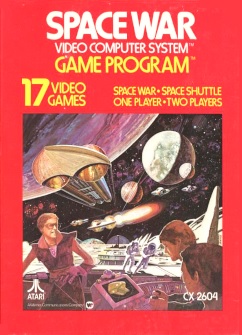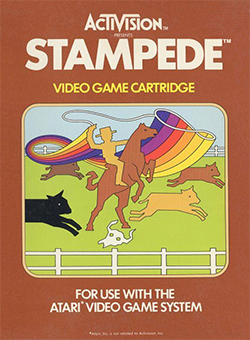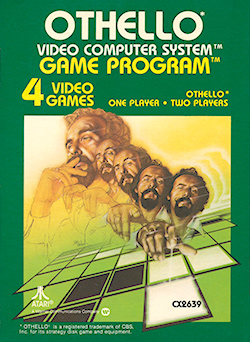
The Atari 2600 is a home video game console developed and produced by Atari, Inc. Released in September 1977 as the Atari Video Computer System, it popularized microprocessor-based hardware and games stored on swappable ROM cartridges, a format first used with the Fairchild Channel F in 1976. The VCS was bundled with two joystick controllers, a conjoined pair of paddle controllers, and a game cartridge—initially Combat and later Pac-Man. Sears sold the system as the Tele-Games Video Arcade. Atari rebranded the VCS as the Atari 2600 in November 1982 alongside the release of the Atari 5200.

The Atari 7800 ProSystem, or simply the Atari 7800, is a home video game console officially released by Atari Corporation in 1986 as the successor to both the Atari 2600 and Atari 5200. It can run almost all Atari 2600 cartridges, making it one of the first consoles with backward compatibility. It shipped with a different model of joystick from the 2600-standard CX40 and Pole Position II as the pack-in game. Most of the announced titles at launch were ports of 1981–1983 arcade video games.

The Intellivision is a home video game console released by Mattel Electronics in 1979. The name is a portmanteau of "intelligent television". Development began in 1977, the same year as the launch of its main competitor, the Atari 2600. In 1984, Mattel sold its video game assets to a former Mattel Electronics executive and investors, eventually becoming INTV Corporation. Game development ran from 1978 to 1990, when the Intellivision was discontinued. From 1980 to 1983, more than 3.75 million consoles were sold. As per Intellivision Entertainment the final tally through 1990 is somewhere between 4.5 and 5 million consoles sold.
The video game crash of 1983 was a large-scale recession in the video game industry that occurred from 1983 to 1985, primarily in the United States. The crash was attributed to several factors, including market saturation in the number of video game consoles and available games, many of which were of poor quality. Waning interest in console games in favor of personal computers also played a role. Home video game revenue peaked at around $3.2 billion in 1983, then fell to around $100 million by 1985. The crash abruptly ended what is retrospectively considered the second generation of console video gaming in North America. To a lesser extent, the arcade video game market also weakened as the golden age of arcade video games came to an end.

Kaboom! is an action video game published in 1981 by Activision for the Atari VCS. It was programmed by Larry Kaplan, and David Crane coded the overlaid sprites. The game was well received and sold over one million cartridges by 1983.

Star Raiders is a space combat simulator video game created by Doug Neubauer and published in 1980 by Atari, Inc.The player assumes the role of a starship fighter pilot, protecting starbases from invading forces called Zylons. Piloting and combat are shown in the 3D cockpit view, while a 2D galactic map showing the status of the Zylon invasion. Neubauer made the game during in his spare time at Atari, inspired by contemporary media such as Battlestar Galactica and Star Wars, as well as the 1971 mainframe game Star Trek. Originally released the Atari 400/800 computers, Star Raiders was later ported to the Atari 2600, Atari 5200, and Atari ST.

Pitfall! is a video game developed by David Crane for the Atari Video Computer System and released in 1982 by Activision. The player controls Pitfall Harry, who has a time limit of 20 minutes to seek treasure in a jungle. The game world is populated by enemies and hazards that variously cause the player to lose lives or points.

Starmaster is a video game written for the Atari 2600 by Alan Miller and published in June 1982 by Activision. The game is similar to Atari 8-bit family game Star Raiders. Starmaster was not ported to other systems, but has been re-released in collections such as Activision Anthology.

Space War is a video game cartridge released by Atari, Inc. in 1978 for the Atari Video Computer System. The game is a version of Spacewar!, the 1962 computer game by Steve Russell. It was released by Sears as Space Combat, for its Atari compatible Tele-Games system. An Atari Lynx update was planned but never released.

Grand Prix is a Formula One Grand Prix motor racing-themed video game. It was designed and programmed by David Crane for the Atari 2600 and published by Activision in 1982.

In the history of video games, the second-generation era refers to computer and video games, video game consoles, and handheld video game consoles available from 1976 to 1992. Notable platforms of the second generation include the Fairchild Channel F, Atari 2600, Intellivision, Odyssey 2, and ColecoVision. The generation began in November 1976 with the release of the Fairchild Channel F. This was followed by the Atari 2600 in 1977, Magnavox Odyssey² in 1978, Intellivision in 1980 and then the Emerson Arcadia 2001, ColecoVision, Atari 5200, and Vectrex, all in 1982. By the end of the era, there were over 15 different consoles. It coincided with, and was partly fuelled by, the golden age of arcade video games. This peak era of popularity and innovation for the medium resulted in many games for second generation home consoles being ports of arcade games. Space Invaders, the first "killer app" arcade game to be ported, was released in 1980 for the Atari 2600, though earlier Atari-published arcade games were ported to the 2600 previously. Coleco packaged Nintendo's Donkey Kong with the ColecoVision when it was released in August 1982.

Ice Hockey is an ice hockey video game designed by Alan Miller for the Atari VCS, and published by Activision in 1981. Actor and comedian Phil Hartman starred in the commercial for the game.

Enduro is a racing video game designed by Larry Miller for the Atari 2600 and published by Activision in 1983. The object of the game is to complete an endurance race, passing a certain number of cars each day to continue the next day. The visuals change from day to night, and there is occasional inclement weather.

Barnstorming is an Atari 2600 video game designed by Steve Cartwright and published by Activision in 1982. It was the first game designed by Cartwright. The idea for Barnstorming came to him as he watched a biplane one day while driving home from work.

Superman is a video game programmed by John Dunn for the Atari Video Computer System and released in 1979 by Atari, Inc. The player controls Superman, whose quest is to explore an open-ended environment to find three pieces of a bridge that was destroyed by Lex Luthor, capture Luthor and his criminal gang, and return to the Daily Planet building. The game world is populated by antagonists such as a helicopter that re-arranges the bridge pieces and roving kryptonite satellites that cause Superman to revert into Clark Kent.

Stampede is a video game written by Bob Whitehead for the Atari Video Computer System and published by Activision in 1981. Stampede is a left-to-right, horizontally-scrolling, action game with a cattle round-up theme. An Intellivision version was released the following year.

Laser Blast is a single-player video game developed and published by Activision in March 1981 for the Atari VCS console. Designed by David Crane, one of Activision's co-founders, Laser Blast places players in control of flying saucers attacking land targets.

Space Shuttle: A Journey into Space is a space flight simulator game designed by Steve Kitchen for the Atari 2600 and published by Activision in 1983. It is one of the first realistic spacecraft simulations available for home systems. Space Shuttle was adapted to the Atari 8-bit family and Atari 5200 by Bob Henderson (1984), then ported to the ZX Spectrum (1984), Commodore 64 (1984), Amstrad CPC (1986), and MSX (1986). The 1984 Activision Software catalog also mentions an Apple II version.

Othello is a 1980 video game developed and published by Atari, Inc. for its Atari Video Computer System. It is based on the variant of Reversi of the same name, originally created in 1971. The VCS game was programmed by Ed Logg and Carol Shaw.


















